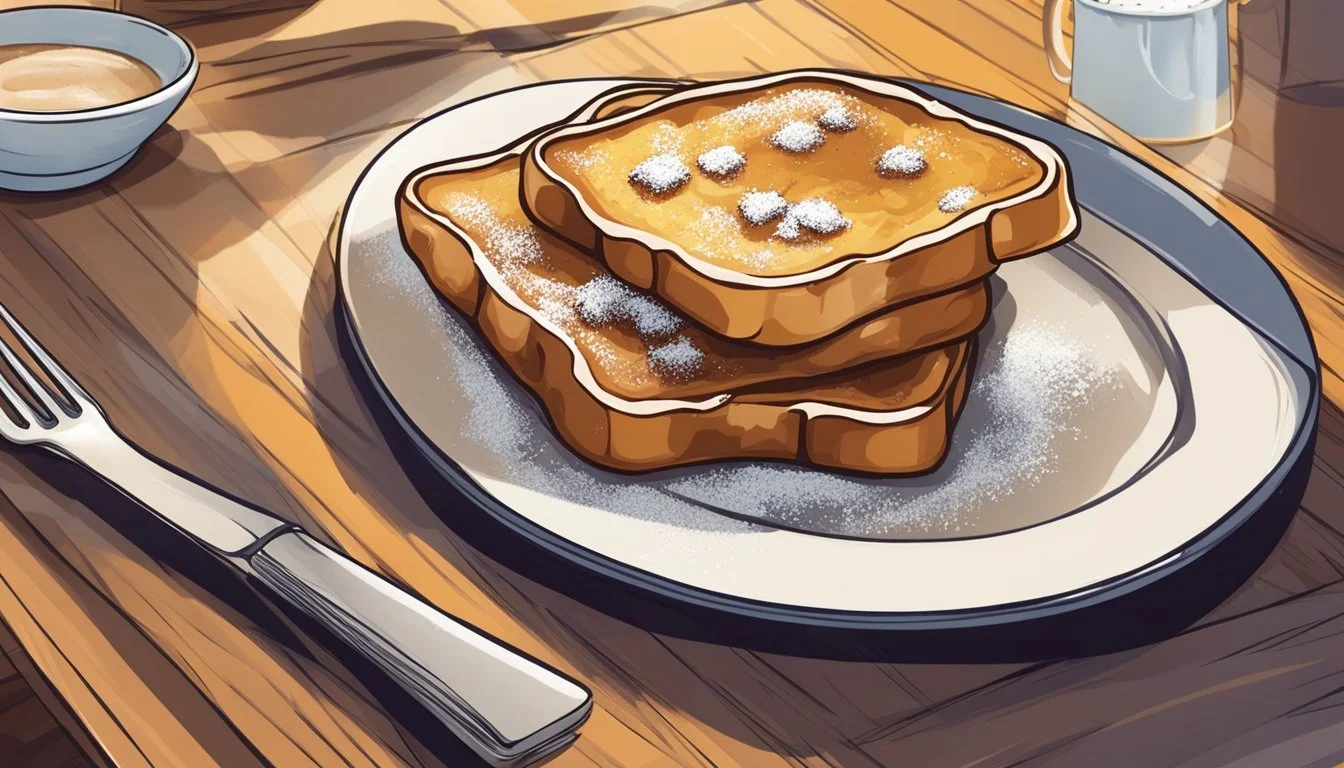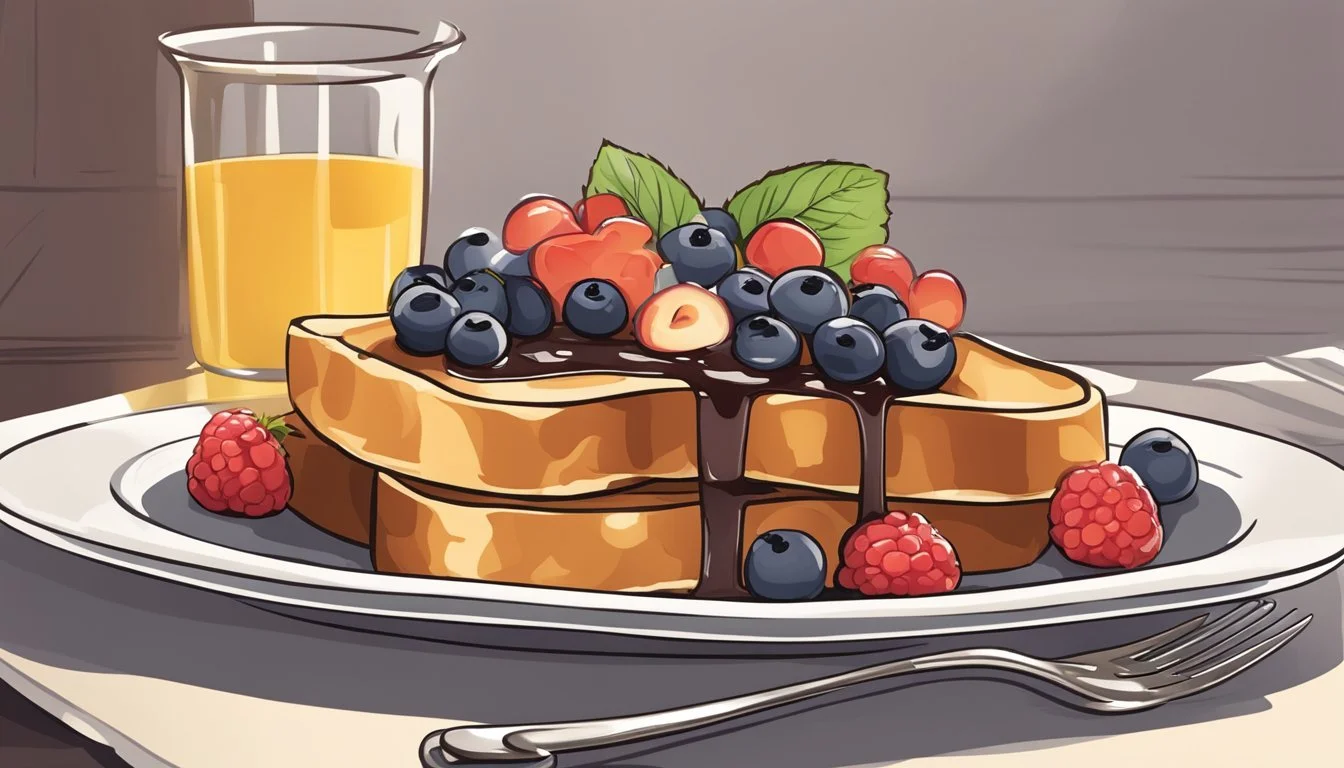How do you eat French Toast?
Mastering the Perfect Breakfast Experience
French toast is a beloved dish that has won the hearts of many through its simple yet delicious combination of flavors and textures. It begins with slices of bread (What wine goes well with bread?), often day-old to provide the needed firmness, which are soaked in a rich mixture of eggs and milk, then cooked to golden perfection. The deceptively simple nature of French toast belies the culinary alchemy that takes place when the egg-soaked bread hits a hot pan, transforming it into a dish with a crispy exterior and a soft, custardy interior.
While often enjoyed for breakfast, French toast's versatility extends to brunch (What wine goes well with brunch?) menus and even dessert tables, proving its adaptability and universal appeal. The key to its success lies not just in the quality of the ingredients but also in the method of preparation. The bread must be sufficiently soaked but not soggy, ensuring each bite is infused with the velvety custard mixture, yet holds up when cooked.
The final enjoyment of French toast lies in its customizability; toppings can range from the simple sprinkle of powdered sugar and a drizzle of maple syrup to fresh berries, whipped cream, and even savory options like bacon (how long does bacon last?) or cheese. This allows the diner to take the dish in whatever direction their taste preferences or meal setting calls for. With each variation, the essence of French toast—its warming, comforting indulgence—remains steadfast, securing its place as a cherished dish in cuisines around the world.
Essential Ingredients
Selecting the right ingredients is pivotal to creating the delectable and rich taste of French toast. Crafting the perfect bite involves using the ideal bread, a well-seasoned egg mixture, and optional flavor enhancers that take the dish to another level.
Choosing the Right Bread
The choice of bread is crucial, as it serves as the foundation for the French toast. The best bread for French toast is often one that is thick and hearty enough to absorb the egg mixture without falling apart. Popular options include:
Brioche: A buttery, slightly sweet bread with a tender crumb that soaks up the custard while maintaining its structure.
Challah: Similar to brioche, this bread has a light texture that complements the richness of the egg mixture.
Sourdough: For those who prefer a tangy flavor, sourdough adds a unique twist and robustness to the dish.
Stale Bread: Bread that is 1-2 days old can often provide better results, as it absorbs the egg mixture more effectively without becoming too soggy.
Preparing the Egg Mixture
The egg mixture, or custard, is the heart of French toast, infusing the bread with moisture and flavor. The mixture typically includes:
Eggs: The main component that sets the custard base.
Milk or Cream: Provides the liquid for the eggs to blend with, with cream offering a richer taste.
Sugar: Adds sweetness and assists in browning the toast.
The egg-to-milk ratio is usually one egg to about a quarter cup of milk or cream, providing the right consistency for the bread to soak up.
Additional Flavor Enhancers
To elevate the French toast, one can introduce a variety of flavor enhancers:
Cinnamon and Nutmeg: Classic spices that offer warmth and depth of flavor.
Vanilla Extract: A dash enhances the custard with a sweet and aromatic profile.
Liqueur: For an adult twist, a small amount of liqueur like Grand Marnier can be added.
Maple Syrup: Drizzled over the finished toast, it's the traditional accompaniment, though other syrups can also be used.
While the basic ingredients lend French toast its iconic taste, these additional elements personalize the dish.
Preparing for Cooking
When creating French toast, success begins with preparation. The initial steps of mixing batter, selecting the right cookware, and achieving the ideal batter-to-bread ratio are crucial for a perfect outcome.
Batter Mixing Techniques
The batter is the foundation of French toast, imparting flavor and texture. A well-mixed batter consists of a precise egg-to-milk ratio. For a classic recipe, one typically uses 1/4 cup of milk with one egg per two slices of bread. Mix until the batter appears smooth, without egg streaks or clumps. To enhance the batter, ingredients such as cinnamon, vanilla extract, or a pinch of salt may be added.
Cookware Selection
The choice of cookware significantly affects the cooking process and the final texture of French toast. A large nonstick skillet is commonly preferred as it allows for even heat distribution and prevents sticking, ensuring golden-brown results. Alternatively, an oven preheated to the desired temperature, combined with a baking sheet for a large batch, can produce uniformly cooked French toast.
Optimizing the Batter-to-Bread Ratio
Balancing the batter-to-bread ratio is essential to prevent sogginess or overly dry French toast. Thick slices absorb more egg mixture than thinner ones, so their soaking time should be adjusted accordingly. Dip each slice into the batter, ensuring it’s coated but not drenched, which is typically around 3 to 4 minutes of soaking. This ensures each piece is moistened through, but still retains structural integrity.
Cooking Methods
Preparing French toast properly involves choosing the right cooking method to achieve a golden brown finish and maintaining the toast at a warm temperature until served.
Stovetop Cooking
The stovetop method, utilizing a skillet, is a classic approach for making French toast. One begins by melting butter in the skillet over low heat to ensure even cooking without burning. The soaked bread slices are then cooked in batches to avoid crowding, allowing sufficient space for them to expand and brown properly. One should aim for a cook time that results in a golden brown exterior while keeping the interior rich and custardy. Monitoring the heat is crucial; keeping it at medium-low prevents the outside from overcooking before the inside is warm.
Baking French Toast
For a variant of the traditional French toast, one can opt for baking, which is an excellent method for serving larger groups or achieving a different texture. In this method, slices of the soaked bread or a French toast casserole mixture are placed in a preheated oven. This process typically requires a warm oven set at a moderate temperature to ensure that the French toast cooks evenly throughout. The result should be uniformly golden brown on top. Baking may also be an ideal method for making French toast casserole, a dish that allows for the toast to be baked in a single layer or in an assembled fashion that includes additional ingredients.
Serving and Presentation
When enjoying French toast, the presentation and choice of toppings and sides elevate the dining experience. This section helps to create a visually appealing and delicious plate.
Suggested Toppings
The right toppings can transform French toast from ordinary to extraordinary. Classic maple syrup is a staple for a reason—it provides a sweet and comforting flavor. A dusting of powdered sugar adds a delicate sweetness and a professional touch. For those who prefer a fruitier taste, adding fresh fruit such as sliced strawberries, blueberries, or an assortment of berries provides a refreshing contrast. To enhance the sweetness, a spoonful of honey or a drizzle of chocolate syrup can be delightful. For a creamy finish, a dollop of whipped cream or a spread of Nutella lends a luscious richness.
Here's a table summarizing some popular French toast toppings:
Topping Type Examples Sweet Syrups Maple syrup, Honey, Chocolate syrup Sugar Powdered sugar Fruits Fresh fruit, Berries, Banana slices Creamy Whipped cream, Nutella Spices Cinnamon
Accompaniments
French toast often comes with sides to balance its sweetness and to make a complete meal. Savory options include bacon strips or sausage links, which contribute a salty crunch that pairs well with the sweetness of the toast. Scrambled eggs or Eggs Benedict can be served alongside for a boost of protein, creating a contrasting texture and flavor profile. For those who enjoy an extra touch of indulgence, additional breakfast items like pancakes or waffles can be offered, although they are comparable in sweetness to French toast.
An accompanying table for common sides:
Accompaniment Type Examples Meats Bacon, Sausage links Eggs Scrambled eggs, Eggs Benedict Other Sweet Items Pancakes, Waffles
French toast servings can be customized to individual tastes, making it a versatile dish that can be enjoyed in various delicious combinations.
Preventing Common Pitfalls
When it comes to French toast, ensuring a perfect balance of texture and temperature is crucial. These tips help prevent the common issues of soggy French toast and incorrect serving temperature.
Avoiding Sogginess
To avoid a soggy outcome, one should consider the bread's density and moisture content. Dense, sturdy breads like brioche and challah are optimal choices as they absorb the custard mixture without falling apart. It's essential to avoid bread that's too fresh or soft.
Here are steps to ensure the French toast is not soggy:
Bread Selection: Choose a dense, spongy bread that holds up well to moisture.
Custard Ratio: Be cautious not to add too much dairy or sugar to the custard. (Ratio: for every 4 slices of bread, use 4 eggs and about 3/4 cup of whole milk or cream).
Skim Milk: Using fattier milk prevents a watery consistency. Avoid skim milk, which tends to remain too liquid during cooking.
Serving Temperature
Serving French toast warm is essential, as its texture and flavor are best experienced when heated properly.
To ensure French toast remains warm until served:
Cook at a medium temperature to allow the inside to warm without burning the outside.
Use a warm oven (around 200°F) to keep cooked slices warm while finishing the remaining pieces.
Warm, crusty French toast is a delightful balance of a lightly crisp exterior with a soft, custardy middle, ensuring an ideal texture and a comforting eating experience.
Variations and Specialties
French toast is a versatile dish that can be enjoyed in its classic form or through numerous variations that cater to different tastes and occasions. Whether one prefers rich, stuffed decadence or a more communal, casserole-style dish, French toast offers a delightful experience.
Stuffed French Toast
In the realm of indulgence, Stuffed French Toast stands out. It begins with thick slices of bread that are slit to create pockets, which are then generously filled with creamy ingredients such as cream cheese, chocolate, Nutella, or a blend of fruit and nuts. Once the bread is soaked in the customary vanilla-infused custard batter, it is cooked to a golden-brown perfection. The result is a sumptuous combination of soft, custardy bread with a molten, flavor-packed center.
French Toast Casserole
French Toast Casserole shifts the classic French toast from stove to oven. This dish involves cutting the bread into cubes and soaking them in the custard mixture, typically made from eggs, milk, vanilla, and sugar. The soaked bread is then poured into a baking sheet, layered with extras like dried fruit, granola, or nuts for added texture, and baked until it forms a golden top. Serving a crowd becomes effortless and elegant with this casserole version, which melds the savory notes of the bread with the rich, sweet flavors of the custard.
Nutritional Information
When discussing French toast, understanding its nutritional value, particularly the calorie content, is key. Choices such as toppings and bread type significantly affect the nutritional profile.
Calorie Content
The calorie content in French toast can vary widely. A single slice of homemade French toast made with low-fat (2%) milk typically contains approximately 150 to 200 calories, depending on the size of the bread and the amount of egg mixture used. However, when French toast is prepared with toppings like syrup, butter, or chocolate, the calorie count increases substantially.
Toppings and Add-Ons:
Butter: One tablespoon adds about 102 calories.
Maple Syrup: A single tablespoon can add about 52 calories.
Chocolate Sauce: Depending on the variety, a tablespoon can have around 50-100 calories.
Protein Content:
A slice of French toast made with low-fat milk provides a modest amount of protein, roughly between 4 to 6 grams, contributing to a satisfying breakfast.
Keep in mind, nutrient values are approximate and can vary based on the recipe and serving size. For those counting calories or monitoring their food intake, being mindful of the quantity and type of toppings can help manage overall calorie consumption.
Side Dishes and Completing the Meal
When enjoying French toast, side dishes can transform a simple breakfast into a well-rounded brunch experience. Sausage and bacon are classic meat accompaniments that provide a savory contrast to the sweetness of French toast. They crispen nicely adding texture and rich flavor to the meal.
A sophisticated option can be Eggs Benedict, which typically includes poached eggs and Canadian bacon atop English muffins, all smothered in creamy Hollandaise sauce. This luxurious addition elevates the brunch experience.
For a healthier side, a variety of fresh fruits or a berry medley offers a refreshing and sweet option, adding a burst of natural flavor and color. Incorporating granola can also introduce a crunchy texture alongside the softness of the French toast, and a dollop of peanut butter provides richness and protein.
Here is a curated list of side dishes to enhance your French toast:
Category Options Meats Sausage, Bacon Eggs Egg Benedict Fruits Berries, Fresh Fruit Extras Granola, Peanut Butter
French toast is often a centerpiece of both breakfast and brunch, especially on a weekend breakfast table. By choosing the right side dishes, one can cater to various taste preferences and dietary needs, whether seeking indulgence or a balanced meal.









